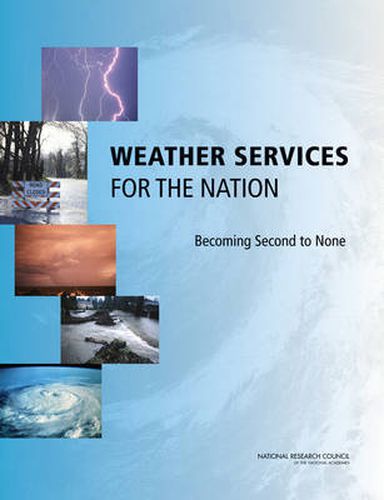Readings Newsletter
Become a Readings Member to make your shopping experience even easier.
Sign in or sign up for free!
You’re not far away from qualifying for FREE standard shipping within Australia
You’ve qualified for FREE standard shipping within Australia
The cart is loading…






During the 1980s and 1990s, the National Weather Service (NWS) undertook a major program called the Modernization and Associated Restructuring (MAR). The MAR was officially completed in 2000. No comprehensive assessment of the execution of the MAR plan, or comparison of the promised benefits of the MAR to its actual impact, had ever been conducted. Therefore, Congress asked the National Academy of Sciences to conduct an end-to-end assessment. That report, The National Weather Service Modernization and Associated Restructuring: A Retrospective Assessment, concluded that the MAR was a success.
Now, twelve years after the official completion of the MAR, the challenges faced by the NWS are no less important than those of the pre-MAR era. The three key challenges are: 1) Keeping Pace with accelerating scientific and technological advancement, 2) Meeting Expanding and Evolving User Needs in an increasingly information centric society, and 3) Partnering with an Increasingly Capable Enterprise that has grown considerably since the time of the MAR.
Weather Services for the Nation presents three main recommendations for responding to these challenges. These recommendations will help the NWS address these challenges, making it more agile and effective. This will put it on a path to becoming second to none at integrating advances in science and technology into its operations and at meeting user needs, leading in some areas and keeping pace in others. It will have the highest quality core capabilities among national weather services. It will have a more agile organizational structure and workforce that allow it to directly or indirectly reach more end-users, save more lives, and help more businesses. And it will have leveraged these capabilities through the broader enterprise. This approach will make possible societal benefits beyond what the NWS budget alone allows.
$9.00 standard shipping within Australia
FREE standard shipping within Australia for orders over $100.00
Express & International shipping calculated at checkout
During the 1980s and 1990s, the National Weather Service (NWS) undertook a major program called the Modernization and Associated Restructuring (MAR). The MAR was officially completed in 2000. No comprehensive assessment of the execution of the MAR plan, or comparison of the promised benefits of the MAR to its actual impact, had ever been conducted. Therefore, Congress asked the National Academy of Sciences to conduct an end-to-end assessment. That report, The National Weather Service Modernization and Associated Restructuring: A Retrospective Assessment, concluded that the MAR was a success.
Now, twelve years after the official completion of the MAR, the challenges faced by the NWS are no less important than those of the pre-MAR era. The three key challenges are: 1) Keeping Pace with accelerating scientific and technological advancement, 2) Meeting Expanding and Evolving User Needs in an increasingly information centric society, and 3) Partnering with an Increasingly Capable Enterprise that has grown considerably since the time of the MAR.
Weather Services for the Nation presents three main recommendations for responding to these challenges. These recommendations will help the NWS address these challenges, making it more agile and effective. This will put it on a path to becoming second to none at integrating advances in science and technology into its operations and at meeting user needs, leading in some areas and keeping pace in others. It will have the highest quality core capabilities among national weather services. It will have a more agile organizational structure and workforce that allow it to directly or indirectly reach more end-users, save more lives, and help more businesses. And it will have leveraged these capabilities through the broader enterprise. This approach will make possible societal benefits beyond what the NWS budget alone allows.